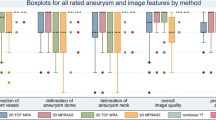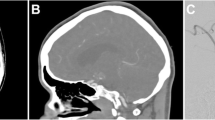Abstract
Computed tomographic angiography (CTA) and magnetic resonance angiography (MSA) have been used recently for evaluation of intracranial aneurysms. If they are to replace conventional digital subtraction angiography (DSA), their sensitivity and specificity should be equal to the latter. In order to determine whether computed tomographic angiography and magnetic resonance angiography can provide the necessary information for presurgical evaluation we compared blindly the results of helical CT angiography and MR angiography with the results of digital subtraction angiography and the intraoperative findings. We evaluated 35 patients with the possible clinical diagnosis of intracranial aneurysm. Our data suggest that both CTA and MRA can provide valuable preoperative information concerning the location, the characteristics and the relationships of most intracranial aneurysms. Both original and reconstructed images should be evaluated together for higher accuracy. In addition helical CT, being a fast, inexpensive and noninvasive method, can be used as a reliable alternative to DSA in emergency situations demanding immediate operation.







Similar content being viewed by others
References
Villablanca JP, Jahan R, Hooshi P et al (2002) Detection and characterization of very small cerebral aneurysms by using 2D and 3D helical CT angiography. AJNR Am J Neuroradiol 23:1187–1198
Villablanca JP, Martin N, Jahan R et al (2000) Volume-rendered helical computerized tomography angiography in the detection and characterization of intracranial aneurysms. J Neurosurg 93:254–264
Velthuis BK, Van Leeuwen MS, Witkamp TD et al (1999) Computerized tomography angiography in patients with subarachnoid hemorrhage: from aneurysm detection to treatment without conventional angiography. J Neurosurg 91:761–767
Leffers AM, Wagner A (2000) Neurologic complications of cerebral angiography. A retrospective study of complication rate and patient risk factors. Acta Radiologica 41:204–210
Hoff DJ, Wallace MC, Brugge KG, Gentili F (1994) Rotational angiography assessment of cerebral aneurysms. AJNR Am J Neuroradiol 15:1945–1948
Harrison MJ, Johnson BA, Gardner GM, Welling BG (1997) Preliminary results on the management of unruptured intracranial aneurysms with magnetic resonance angiography and computed tomographic angiography. Neurosurgery 40:947–955
Kallmes DF, Evans AJ et al (1996) Optimization of parameters for the detection of cerebral aneurysms: CT angiography of a model. Radiology 200:403–405
Velthuis BK, Van Leeuwen MS, Witkamp TD,Boomstra S, Ramos LMP, Rinkel GJE (1997) CT angiography: source images and postprocessing techniques in the detection of cerebral aneurysms. AJR Am J Roentgenol 169:1411–1417
Korogi Y, Takahashi M, Mabuchi N et al (1996) Intracranial aneurysms: diagnostic accuracy of MR angiography with evaluation of maximum intensity projection and source images. Radiology 199:199–207
Young N, Dorsch NWC, Kingston RJ, Markson G, McMahon J (2001) Intracranial aneurysms: evaluation in 200 patients with spiral CT angiography. Eur Radiol 11:123–130
Wilcock D, Jaspan T et al (1996) Comparison of magnetic resonance angiography with conventional angiography in the detection of intracranial aneurysms in patients presenting with subarachnoid haemorrhage. Clinical Radiology 51:330–334
Raaymakers TWM, Buys PC, Verbeeten B Jr et al (1999) MR Angiography as a screening tool for intracranial aneurysms: feasibility, test, characteristics, and interobserver agreement. AJR Am J Roentgenol 173:1469–1475
Ross J, Masaryk TJ, Modic MT et al (1990) Intracranial aneurysms: evaluation by MR angiography. AJR Am J Roentgenol 155:159–165
Schwartz RB, Tice HM, et al (1994) Evaluation of cerebral aneurysms with helical CT: correlation with conventional angiography and MR angiography. Radiology 192:717–722
Hsiang JNK, Liang EY, Lam JMK et al (1996) The role of computed tomographic angiography in the diagnosis of intracranial aneurysms and emergent aneurysm clipping. Neurosurgery 38:481–487
Velthuis BK, Rinkel GJE et al (2001) Surgical anatomy of the cerebral arteries in patients with subarachnoid hemorrhage: comparison of computerized tomography angiography and digital subtraction angiography. J Neurosurg 95:206–212
Author information
Authors and Affiliations
Corresponding author
Rights and permissions
About this article
Cite this article
Kouskouras, C., Charitanti, A., Giavroglou, C. et al. Intracranial aneurysms: evaluation using CTA and MRA. Correlation with DSA and intraoperative findings. Neuroradiology 46, 842–850 (2004). https://doi.org/10.1007/s00234-004-1259-2
Received:
Accepted:
Published:
Issue Date:
DOI: https://doi.org/10.1007/s00234-004-1259-2




